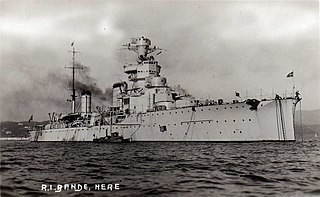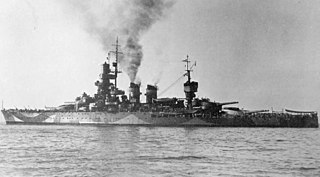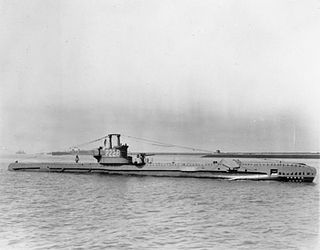
The Second Battle of Sirte was a naval engagement in the Mediterranean Sea, north of the Gulf of Sidra and southeast of Malta, during the Second World War. The escorting warships of a British convoy to Malta held off a much more powerful squadron of the Regia Marina. The British convoy was composed of four merchant ships, escorted by four light cruisers, one anti-aircraft cruiser and 17 destroyers. The Italian force comprised a battleship, two heavy cruisers, one light cruiser and ten destroyers. Despite the initial British success at warding off the Italian squadron, the Italian Fleet attack delayed the convoy's planned arrival before dawn, which exposed it to intense air attacks that sank all four merchant ships and one of the escorting destroyers in the following days.

Giovanni delle Bande Nere was an Italian light cruiser of the Giussano class, which served in the Regia Marina during World War II. She was named after the eponymous 16th-century condottiero and member of the Medici family. Her keel was laid down in 1928 at Cantieri Navali di Castellammare di Stabia, Castellammare di Stabia; she was launched on 27 April 1930, and her construction was completed in 1931. Unlike her three sisters, the finish and workmanship on the vessel were not rated highly. She was sunk on 1 April 1942 by the British submarine HMS Urge.

The Battle of the Mediterranean was the name given to the naval campaign fought in the Mediterranean Sea during World War II, from 10 June 1940 to 2 May 1945.

The Turbine-class destroyer was a group of eight destroyers built for the Regia Marina in the 1920s. The ships played a minor role in the Spanish Civil War of 1936–1937, supporting the Nationalists. All the ships of the class were lost during World War II.

The Andrea Doria class was a pair of dreadnought battleships built for the Royal Italian Navy between 1912 and 1916. The two ships—Andrea Doria and Duilio—were completed during World War I. The class was an incremental improvement over the preceding Conte di Cavour class. Like the earlier ships, Andrea Doria and Duilio were armed with a main battery of thirteen 305-millimeter (12.0 in) guns.

The Folgore class were a group of four destroyers built for the Regia Marina in the 1930s. None of the ships survived World War II.

The Battle of the Duisburg Convoy, also known as the Battle of the BETA Convoy, was fought on the night of 8/9 November 1941 between an Italian convoy, its escorts and four British ships. The convoy was named "BETA" by the Italian naval authorities and carried supplies for the Italian Army, civilian colonists and the Afrika Korps in Italian Libya.

HMS Splendid was a third-batch S-class submarine built for the Royal Navy during World War II. She was laid down on 7 March 1941 and launched on 19 January 1942. After an initial patrol through the Bay of Biscay to Gibraltar, Splendid conducted two patrols in the Mediterranean Sea; one was abandoned after technical problems and on the other she sank two Italian ships. On her next patrol, the submarine attacked two Italian convoys, sinking an Italian destroyer in the second attack. Based in Algiers, the boat operated north of Sicily, sinking six Italian ships, including two tankers and two heavy merchant ships. Splendid was detected by a German destroyer on 21 April 1943 while patrolling off Naples, Italy; the submarine was attacked with depth charges by the destroyer and forced to surface, after which she was scuttled and her surviving crew members taken prisoner. She was the most successful British submarine by tonnage sunk between November 1942 and May 1943.

Pola was a Zara-class heavy cruiser of the Italian Regia Marina, named after the Italian city of Pola. She was built in the Odero Terni Orlando shipyard in Livorno in the early 1930s and entered service in 1932. She was the fourth and last ship in the class, which also included Zara, Fiume, and Gorizia. Compared to her sisters, Pola was built as a flagship with a larger conning tower to accommodate an admiral's staff. Like her sisters, she was armed with a battery of eight 203-millimeter (8.0 in) guns and was capable of a top speed of 32 knots.

The Italian torpedo boat Lupo was a Spica-class torpedo boat built for the Regia Marina in the late 1930s. During the Second World War, Lupo was involved in several naval actions, including that of the eponymous "Lupo convoy", for which she was awarded the Silver Medal of Military Valour. Lupo was sunk in action on 2 December 1942.

Leone Pancaldo was one of twelve Navigatori-class destroyers built for the Regia Marina between the late 1920s. Shortly after Italy's entry into World War II in June 1940, she was sunk by British torpedo bombers in Augusta, Sicily, but was later refloated and repaired. She was briefly used in fast troop transport missions to Tunisia until her second and final sinking by Allied aircraft in April 1943.

The Attack on Convoy AN 14 was a naval engagement during the Second World War between a British naval force defending a convoy of merchant ships, sailing from Port Said and Alexandria to Piraeus in Greece and two Italian torpedo boats which intercepted them north of the island of Crete on 31 January 1941. The Italian vessels, Lupo and Libra launched two torpedoes each. The torpedoes fired by Libra missed their target but one from Lupo hit the 8,120 GRT British tanker Desmoulea which had to be towed to Suda Bay in Crete and beached; the ship was disabled for the rest of the war. One other merchant ship turned back; the other eight vessels reached Piraeus.

Ascari was one of nineteen Soldati-class destroyers built for the Regia Marina in the late 1930s and early 1940s. Completed in mid-1939, she was the last of the first batch of a dozen ships to enter service.

Alvise Da Mosto was one of twelve Navigatori-class destroyers, built for the Regia Marina between the late 1920s and the early 1930s. During World War II, she participated in several minelaying missions in the Sicilian Channel and escorted convoys between Italy and Libya until her sinking by the British Force K.

Freccia was the lead ship of her class of four destroyers built for the Regia Marina in the early 1930s. Completed in 1931, she served in World War II and previous conflicts.

Pegaso was a torpedo boat and an escort aviso of the Italian Regia Marina. She was one of the most successful Axis anti-submarine warships of World War II.

The Italian torpedo boat Sagittario was a Spica-class torpedo boat built for the Regia Marina in 1936. During the Battle of the Mediterranean, in the Second World War, Sagittario was involved in several convoy missions, the most notable that known as the "Sagittario convoy", in the course of the Battle of Crete, for which her commander, Giuseppe Cigala Fulgosi, was awarded the Gold Medal of Military Valour. Sagittario survived the war. Re-classified as corvette in 1949, she was scrapped in 1964.

Giuseppe Fontana was an Italian naval officer during World War II.
The Admirals' Trial was a show trial held in May 1944 by the Special Tribunal for the Defense of the State of the Italian Social Republic against a group of admirals of the Regia Marina, accused of treason by the Italian Social Republic for their behaviour in the summer of 1943 and after the armistice of Cassibile.


















